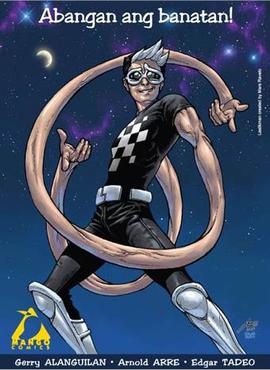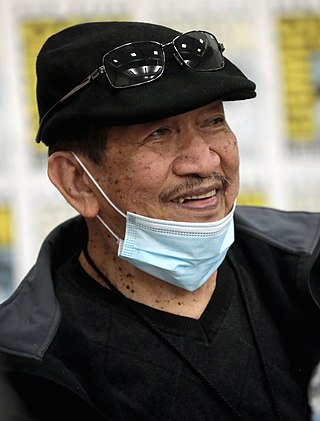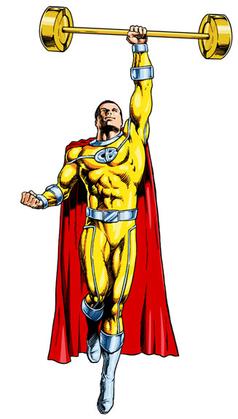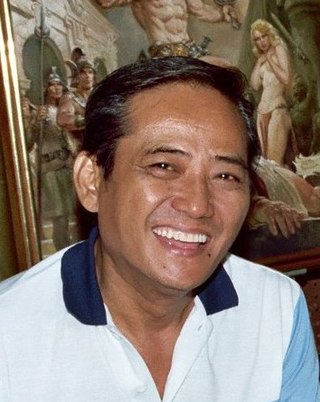
Darna is a superhero who appears in Filipino comic books created by writer Mars Ravelo and artist Nestor Redondo. The character was introduced during the Golden Age of Comic Books, debuting in Pilipino Komiks #77 on May 13, 1950. Darna is a retooling of Ravelo's earlier character, Varga, which first appeared in Bulaklak Magazine, Volume 4, #17 on July 23, 1947. With her continued presence in literature and art, Darna has been described as a Filipino cultural icon. Throughout the years, she has been adapted to a number of media platforms, such as film, television, plays and video games.

Antony de Zuñiga who worked primarily under the name Tony DeZuniga, was a Filipino comics artist and illustrator best known for his works for DC Comics. He co-created the fictional characters Jonah Hex and Black Orchid.

Lastikman, originally spelled Lastik Man, is a fictional character and Filipino comics superhero created by Mars Ravelo and artist Mar T. Santana. Lastikman or the original spelling of Lastik Man debuted in comics format in Aliwan Komiks #56. Based on DC Comics' Plastic Man, and/or Marvel's Mister Fantastic from Fantastic Four, Lastikman can also stretch and transform into many imaginable forms and shapes he desires.

Lauro "Larry" Zarate Alcala was a well-known editorial cartoonist and illustrator in the Philippines. In 2018, he was posthumously conferred the National Artist for Visual Arts title and the Grand Collar of the Order of National Artists.
Rafael Kayanan is a Filipino-born naturalized American comics artist and Filipino martial arts master in the Sayoc Kali system.
Comics have been popular throughout the Philippines from the 1920s to the present. Komiks were partially inspired by American mainstream comic strips and comic books during the early 20th century. The medium first became widely popular after World War II. Its mainstream appeal subsided somewhat during the latter part of the 20th century with the advent of other mass-media forms such as telenovelas, but experienced a renaissance in the mid-2010s with the increasing popularity of artists such as Gerry Alanguilan, Arnold Arre, Budjette Tan, Kajo Baldisimo, and the rise of fan communities through comic book conventions such as komikon. Webcomics produced by independent Filipino web-based artists have caught the attention of local and foreign readers.

Alfredo P. Alcala was a Filipino comics artist, born in Talisay, Negros Occidental in the Philippines. Alcala was an established illustrator whose works appeared in the Alcala Komix Magazine. His 1963 creation Voltar introduced him to an international audience, particularly in the United States. Alcala garnered awards in science fiction during the early part of the 1970s.
Jim M. Fernandez was a Filipino comic book artist best known for his works on Aztec and Aliwan Komiks. He also popularized the fictional character, Zuma in his novels. Apart from being an editor, illustrator, cartoonist, and writer for Philippine comics, Fernandez was also a certified public accountant in the Philippines.

Alex Niño is a Filipino comics artist best known for his work for the American publishers DC Comics, Marvel Comics, and Warren Publishing, and in Heavy Metal magazine.

Captain Barbell is a Filipino superhero created by writer, Mars Ravelo and artist Jim Fernandez. His characteristics are similar to American fictional superheroes Superman, DC Comics' Captain Marvel or Shazam, and Thor but Ravelo based his backstory on Captain America. He first appeared in Pinoy Komiks #1 on May 23, 1963. He also appeared in Kampeon Komiks.

Nestor P. Redondo was a Filipino comics artist best known for his work for DC Comics, Marvel Comics, and other American publishers in the 1970s and early 1980s. In his native Philippines, he is known for co-creating the superheroine Darna.
Komikon is an annual comic book fan convention in the Philippines founded by Artist's Den to be the first convention solely dedicated for comic book enthusiasts. The first convention was held at the U.P. Bahay ng Alumni, UP Diliman, Quezon City, on October 22, 2005. Since then, Filipino fans have gathered annually to meet with the country's local talents and exchange common interest in the comic book genre.

The Savage Sword of Conan was a black-and-white magazine-format comic book series published beginning in 1974 by Curtis Magazines, an imprint of American company Marvel Comics, and then later by Marvel itself. Savage Sword of Conan starred Robert E. Howard's most famous creation, Conan the Barbarian, and has the distinction of being the longest-surviving title of the short-lived Curtis imprint.
Lagim is one of the first Filipino superhero characters in the Philippines. He was created by Filipino artist Cris CaGuintuan. Lagim's first appearance was in the pages of Pilipino Komiks #60 in 1947 or 1949. His sidekick was a boy named Levy, a young lad he saved in the past, and wore a costume similar to the uniform worn by Robin, the sidekick of the American superhero Batman.

Francisco V. Coching was a Filipino comic books illustrator and writer and is regarded as one of the “pillars of the Philippine Komiks Industry”. He served as both illustrator and writer for his comic book stories, Coching is referred to as the "King of Komiks", and as the "Dean of Philippine Comics". In 2014, he was posthumously conferred as a National Artist for Visual Arts, the highest honor for artists in the Philippines.

Ukala (Ang Walang Suko), meaning "Ukala (The Unrelenting)" [i.e. the one who doesn't give up] was a comic strip title in Philippine comics. The main character in the comic book story is Ukala. Ukala was created in the 1950s by distinguished Filipino illustrator Alfredo Alcala. Ukala, the character, was a Native American Indian or "Amerindian". The story, written and illustrated by Alcala for Filipino readers, was about the adventures of Native American Indians set at a timeline when the first Europeans arrived in the Northwestern region of the Americas. Ukala was adapted into film as Ukala (Ang Walang Takot), meaning "Ukala (The Fearless)" in the Tagalog language. It appeared on the pages of the Philippine comic book named Pilipino Komiks. It had been made into movie by Sampaguita Pictures, directed by Artemio B. Tecson in 1954. Leading performers were Cesar Ramirez in the title role and Alicia Vergel as Margarita.
Virgilio "Virgil" Redondo y Purugganan was a Filipino comic book writer and artist.
Celso L. "Sonny" Trinidad was a Filipino comics artist who worked in the Filipino and American comic book industries. In the U.S., he is mostly known for his work for Marvel Comics in the mid–1970s.












